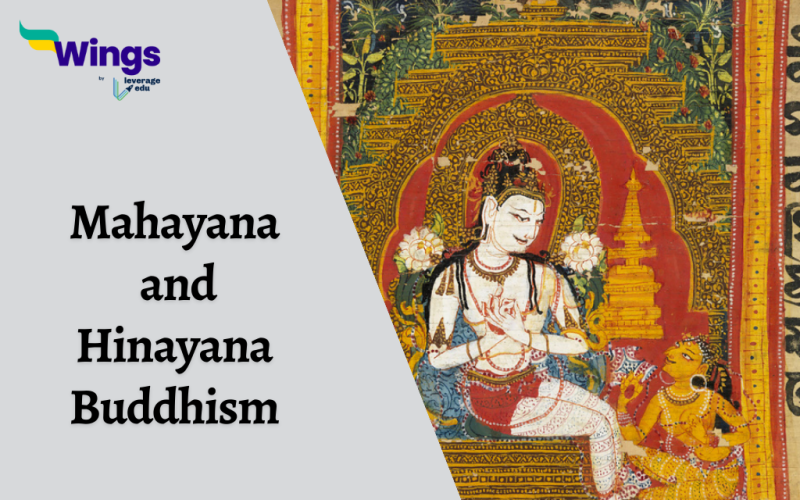Buddhism is a widely practised religion that originated in ancient India and has since spread to various parts of the world. After the demise of Gautam Buddha, within Buddhism there developed different schools or sects, each with its unique beliefs and practices. Out of them, Two prominent branches are Mahayana Buddhism (Greater Vehicle or Vast Vehicle) and Hinayana Buddhism (Lesser Vehicle or Modest Vehicle), which we will explore in detail below.
Table of Contents

What is Mahayana Buddhism?
Mahayana Buddhism is one of the major branches of Buddhism and is widely practised in East Asia, including countries like China, Japan, and Korea. Here are some important characteristics of Mahayana Buddhism:
- Bodhisattva Ideal: Mahayana Buddhism places great emphasis on the concept of the bodhisattva, an enlightened being who vows to help all sentient beings attain enlightenment before reaching their own liberation. This compassion-driven ideal distinguishes Mahayana Buddhism from other branches.
- Expanded Scriptures: Mahayana Buddhism recognizes additional sutras and texts as authoritative beyond the original Buddhist canon. These include the Lotus Sutra, the Heart Sutra, and the Diamond Sutra, among others.
- Universal Liberation: Mahayana Buddhism teaches that all beings have the potential to attain enlightenment and aims to benefit all sentient beings in achieving liberation.
Also Read – Buddhist Councils: History, List and Teachings
What is Hinayana Buddhism?
Hinayana Buddhism, also known as Theravada Buddhism, is another significant branch of Buddhism primarily followed in Southeast Asia, including countries such as Sri Lanka, Thailand, and Myanmar (Burma). Let’s take a closer look at its distinguishing features:
- Focus on Personal Liberation: Unlike Mahayana Buddhism, Hinayana Buddhism emphasizes individual liberation and enlightenment. The goal is to achieve nirvana and end the cycle of rebirth through personal effort and practice.
- Strict Adherence to Pali Canon: Hinayana practitioners consider the Pali Canon, the earliest recorded Buddhist scripture, as the most authoritative and strictly follow its teachings.
- Monastic Tradition: Monasticism is highly valued in Hinayana Buddhism, with monks and nuns dedicating their lives to the path of enlightenment through meditation, discipline, and study.
Also Read – Buddhist Education System: Features, Role & Merits
What are the Differences between Mahayana Buddhism and Hinayana Buddhism?
The Difference between Mahayana Buddhism and Hinayana Buddhism is –
| Mahayana Buddhism | Hinayana Buddhism |
| “Great Vehicle” and represents a more vast and inclusive approach to Buddhism | Hinayana means “Lesser Vehicle” |
| Emphasizes the bodhisattva ideal, attaining enlightenment for the benefit of all beings. | Focuses on individual liberation and enlightenment. |
| Views the historical Buddha, Siddhartha Gautama, as one of many enlightened beings known as Bodhisattvas. | Considers the historical Buddha as the only Arahat or enlightened being. |
| Believes in the concept of “skilful means” (upaya). | Emphasizes the cultivation of moral discipline, mindfulness, and insight meditation. |
| The Scriptural language of this Buddhism is Sanskrit. | The Scriptural language of this Buddhism is Pali |
| The three bodies of a Buddha are accepted in Mahayana Buddhism. They are as follows: Nirmanakaya Sambhogakaya Dharmakaya | Hinayana does not believe in the three bodies of a Buddha as they believe an individual must find their own path to salvation. |
| Acknowledges the existence of celestial beings and deities known as bodhisattvas. | Focuses mainly on individual practice and does not actively involve celestial beings. |
| Popular in countries such as China, Japan, Korea, and Vietnam. | More prevalent in countries like Sri Lanka, Myanmar, Cambodia, and Thailand |
| Recognizes multiple paths to enlightenment and allows for a diverse range of practices. | Emphasizes strict adherence to monastic rules and monastic life as the primary path to liberation. |
| The ten qualities that Mahayana seeks are – Patience Generosity Perseverance Wisdom Mental Stability Skills in Means Strengthening Aspirational Prayers Deep Awareness Self-Discipline | The ten qualities that Hinayana seeks are – Patience Generosity Perseverance Wisdom Being True to one’s words Renunciation Love Resolution Equanimity Self-Discipline |
Also Read – Buddhist Councils: History, List and Teachings
Similarities between Mahayana Buddhism and Hinayana Buddhism
While Mahayana Buddhism and Hinayana Buddhism have distinct characteristics, they also share some commonalities. Some of them are –
- Middle Path: Both branches derive from the Middle Path or the Noble Eightfold Path, which serves as a guide to achieving enlightenment and liberation.
- Concepts of Karma and Rebirth: Both Mahayana and Hinayana Buddhism believe in the concepts of karma (the law of cause and effect) and rebirth (the cycle of death and rebirth).
- Four Noble Truths: Both traditions uphold the teachings of the Four Noble Truths elucidated by the Buddha, which offer a deeper understanding of the nature of suffering and the path to liberation.
That’s all about Mahayana and Hinayana Buddhism. If you want to read more articles like this, you can get Study notes on the Modern History of India here. Also, you can visit our general knowledge page on Indian History!
 One app for all your study abroad needs
One app for all your study abroad needs













